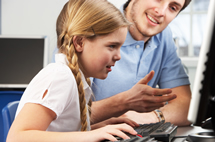Blended learning programs offer much customization
Blended learning–a combination of face-to-face and online learning–is piloted in schools and districts across the nation. Advocates note that students are able to learn at a more individualized pace, and they also can access courses that might not be offered at their own brick-and-mortar school.
In his book Disrupting Class, author Clayton Christensen notes that by 2019, half of all high school courses will be delivered online.
And while educators agree on its basic definition, blended learning looks quite different in every classroom, although using technology as a tool to support teachers remains key in all blended learning’s forms.
Continued research on blended learning has led to four primary models that are evident in K-12 schools today, as outlined in “Is K-12 Blended Learning Disruptive? [1],” a May 2013 Clayton Christensen Institute report authored by Clayton Christensen, Michael B. Horn, and Heather Staker.
(Next page: Four different blended learning models; Plus, take our poll on blended learning)In 2000, approximately 45,000 K-12 students took a course online. In 2009, more than 3 million K-12 students took at least one online course.
Here’s a look at four different blended learning models:
In a Rotation model, students rotate on a fixed schedule, spending some time immersed in traditional face-to-face learning and some time learning online. This model includes four sub-models:
- The Station Rotation model involves students rotating in a contained classroom
- The Lab Rotation model involves students learning in a classroom and going to a learning lab for online learning. Rocketship Education in San Jose, Calif., is an example of the Lab Rotation model. Up to four classes of students engage in a learning lab for 100-minute blocks, in which they spend 60-80 minutes of that time in self-directed online learning. Those students then move to other classrooms for literacy, math, science, and social studies with face-to-face teachers.
- The Flipped Classroom model involves rotation between a school for face-to-face teacher-guided work, and the student’s home or an off-site location for online learning
- The Individual Rotation model gives each student an individualized playlist
The Flex model “is one in which online learning is the backbone of student learning,” according to the report. Student schedules are individualized and their main teacher is off-site.
Students in AdvancePath Academics, which establishes learning academics on high school campuses to help dropouts, move through courses at their own pace and a face-to-face teacher is on hand to intervene and assist as needed. The model uses Apex Learning as its core curriculum, American Education A+ for electives and non-core courses, and ALEKS Math and Achieve 3000 for additional, more targeted student needs.
The A La Carte model combines online learning and brick-and-mortar education. In this model, students take one or more courses online with an online teacher, and also maintain brick-and-mortar education. Online courses are taken either off-site or in the brick-and-mortar schools.
The Enriched Virtual model lets students divide their learning between brick-and-mortar and online methods. Within each course, students split their time between both learning methods.
[poll id=”49″]
(Next page: An infographic outlining blended learning forms)
Click the image to view larger.
